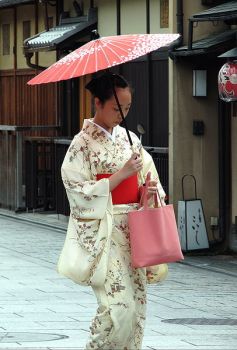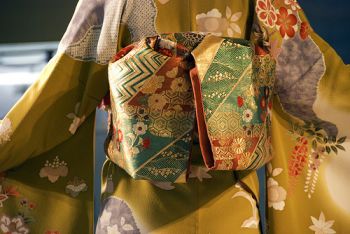Kimono
Kimono is a traditional Japanese garment. It is worn by both sexes and all generations of the Japanese. Kimono is considered a national symbol of Japan.
Kimono is made of one piece of fabric called a “tan.” The tan is no more than 36 cm wide and 11.43 metres long. When finished kimono consists of four pieces of fabric – two covering the body and two that form the sleeves. Sometimes there are two extra pieces that form the narrow front panels and collar.
Kimono is usually sewn by hand. Materials used to make a kimono are silk, silk brocade, silk crepes and satin weaves. Nowadays there are also cheaper kimonos made of cotton, polyester or some other artificial material. People usually wear kimono over one or more undergarments.
 Kimono – true symbol of Japan
Kimono – true symbol of Japan
There is a relation between pattern of the kimono and part of year when they are worn. Let's take for example spring. Kimono worn then has beautiful cherry blossoms and butterfies. If looked very carefully, kimono can tell you whether the person wearing it is married or not. Young single women wear kimono with longer sleeves. Their kimonos are also made of fabric with more lively patterns than those worn by older women. The most popular types of female kimono are Furisode, Homongi, Iromuji, Komon, Mofuku, Tomesode, Tsukesage, Uchikake and Susohiki.
Male kimonos are of more subtle colours (black, dark blue, green, brown). Some kimonos include a “kamon” or family crest. There are also more casual male kimonos made of cotton or polyester. They are a bit lightly coloured.
Kimono is worn with the “obi” (sash). Obi worn with formal female kimono can be 30 centimetres wide and over 4 metres long. These obis are very colourful. They are made of brocade. Types of female obi are Darari obi, Fukoro obi, Fukoro Nagoya obi, Hakata obi etc. This is not all. Numerous accessories are used to put an obi and keep it in proper form. One of such accessories is little pillow called “obimakura.”
 Obi
Obi
Obi worn with male kimono is much more simple. It is about 10 centimetres wide. There are two main types of male obis – the informal one called Heko obi and the formal one called Kaku obi. There are numerous rules how to tie an obi knot and which one to use. There are many obi knots – Asago musabi, Ayame musabi, Bara musabi, Darari musabi etc.